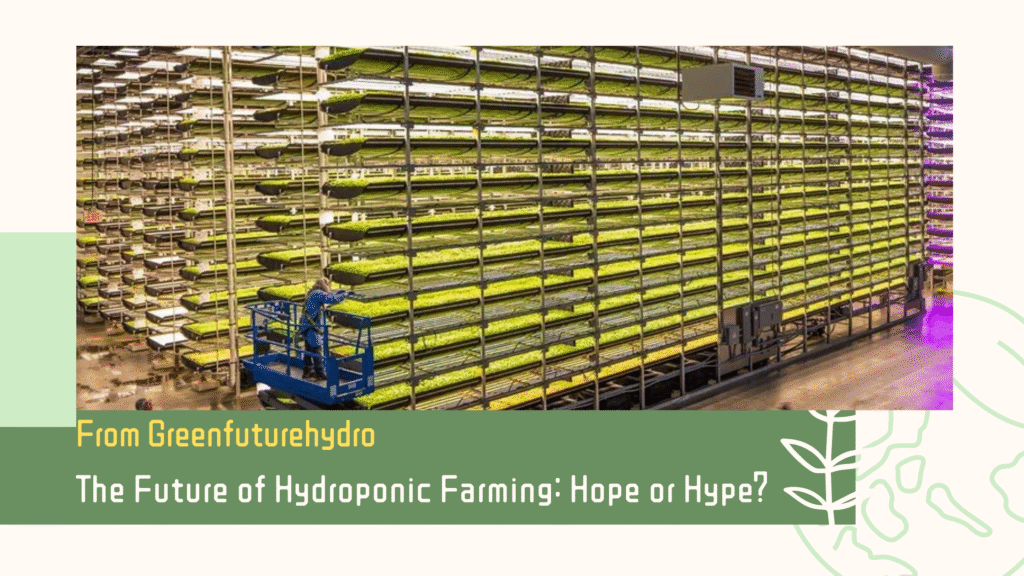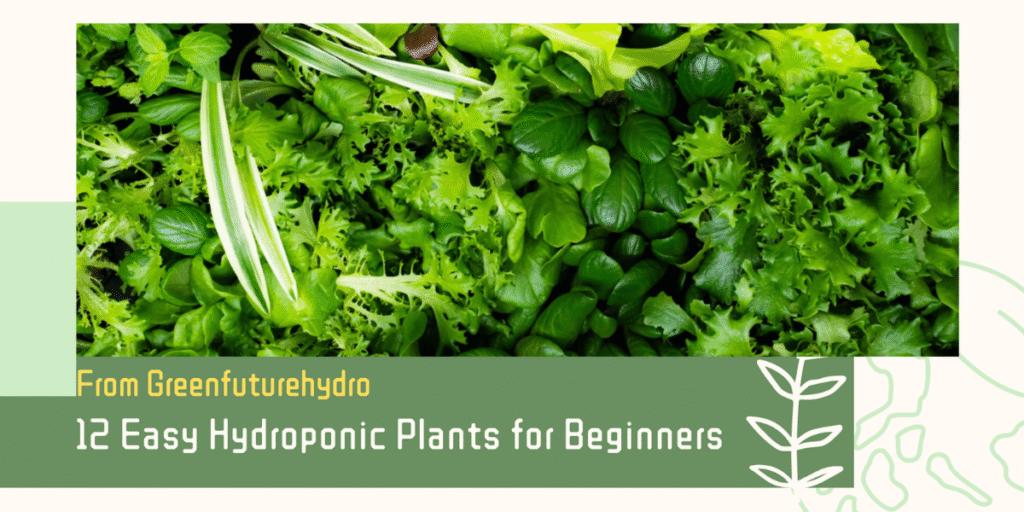Future of Hydroponic Farming is on everyone’s mind lately.
Hey plant lover! You’ve probably seen crisp lettuce growing in water or tomatoes hanging from vertical towers and thought, “Is this really the future of farming, or just a flashy trend?”
You’re not alone in wondering. Let’s explore what hydroponics is all about, what’s hype, what’s real, and whether it’s something worth rooting for.
Future of Hydroponic Farming: Real Benefits
HHydroponic farming isn’t just a high-tech curiosity, it’s emerging as a serious, sustainable alternative to traditional agriculture. Here’s why so many believe in its potential:
Significantly reduces water use, Hydroponic systems use up to 90% less water than soil-based farming, making them ideal for drought-prone regions. Optimized for urban environments , Vertical farming allows fresh produce to be grown in compact indoor spaces, from rooftops to repurposed shipping containers.
Less soil, fewer problems , No soil means no soil-borne pests, weeds, or diseases, which reduces the need for chemical pesticides. Faster, controlled growth, With precise control over nutrients, pH, and lighting, plants grow faster and more consistently year-round.
All-season production, No matter the weather outside, hydroponic systems keep producing fresh greens indoors, even during harsh winters. And let’s be honest, there’s something genuinely satisfying about watching healthy roots thrive in crystal-clear water.
Getting Started with Hydroponic Farming’s Future
Getting into hydroponics doesn’t require a fancy setup or a background in science. With just a few basic tools and the right plant, you can start growing successfully at home. Here’s a simple beginner-friendly path:
Choose an easy starter plant
Go for fast-growing, low-maintenance crops like lettuce, basil, or mint. These plants are forgiving, quick to harvest, and ideal for first-timers.
Set up a basic system
A DWC (Deep Water Culture) setup is one of the simplest hydroponic methods. All you need is a food-grade bucket, a net pot, an air pump, and a growing medium like clay pebbles or sponges.
Add nutrients and monitor
Use a balanced hydroponic nutrient solution (Part A & B). Regularly check the pH level (ideally 5.5–6.5) and make sure water levels stay consistent to keep roots healthy and oxygenated.
New to this whole thing? Peek at our Hydroponics 101 ,it’s a super chill starter guide.
Sustainability in Hydroponic Farming’s Future
As water scarcity worsens and arable land continues to diminish, hydroponic farming offers significant climate-friendly advantages that make it a smart choice for the future of agriculture:
Ideal for urban farming
Hydroponics enables efficient food production in cities, utilizing vertical space and reducing the need for large farmland.
Dramatically reduces water usage
By recycling nutrient solutions, hydroponic systems can use up to 90% less water than traditional soil-based agriculture.
Well-suited for drought-prone areas
With minimal water requirements and controlled environments, hydroponics provides a reliable solution for regions facing water shortages.
In short, hydroponic farming isn’t just innovative, it’s a cornerstone of climate-smart agriculture for a sustainable future.
Global Trends in Hydroponic Farming’s Future
Hydroponics is far from a niche trend, it’s a global movement transforming agriculture in diverse environments:
🇳🇱 Netherlands: A world leader in high-tech greenhouse farming, pioneering advanced hydroponic systems for tomatoes and peppers with remarkable efficiency and yield.
🇯🇵 Japan: Innovative indoor farms in urban centers and shopping malls produce fresh leafy greens year-round, maximizing limited space through vertical hydroponic setups.
🇺🇸 USA: Urban vertical farms are flourishing in basements and rooftops, combining technology and sustainability to supply local communities with fresh produce.
🇦🇪 United Arab Emirates: Leading efforts to combat desertification by deploying hydroponic farms that thrive in arid climates, turning barren landscapes into productive green spaces.
Want some easy wins before you go global? Start with our top 12 beginner-friendly plants ,these are total game-changers for your first grow.
FAQs on the Future of Hydroponic Farming
Q1: Is hydroponics just a passing trend?
Not at all. While it might look futuristic, hydroponics is already being used around the world to solve very real issues , like food scarcity in urban areas and farming in extreme climates (hi, Dubai 👋). From rooftop gardens in New York to high-tech lettuce farms in Tokyo malls, it’s not hype ,it’s happening. Plus, with younger generations super into sustainability, this trend’s got deep roots.
Q2: Will hydroponic veggies be less nutritious than soil-grown ones?
Surprisingly, nope. In fact, hydroponic veggies can be just as rich in vitamins and minerals ,sometimes even more so, because you control exactly what nutrients they get. No guessing games with soil quality. As long as your nutrient mix is right and you give your plants proper care (hello, pH meter 👀), you’ll get crisp, flavorful greens packed with goodness.
Q3: Isn’t hydroponics too expensive for a home setup?
It doesn’t have to be. While big systems can get pricey, you can start super simple, think a DIY DWC bucket or a mini tower system for around $50–$100. That’s less than what most of us spend on takeout in a weekend. And the best part? Once you’re set up, you’ll have fresh herbs and greens at your fingertips for weeks. Budget-friendly and delicious.
Q4: What if I don’t have any natural sunlight at home?
No biggie! This is where full-spectrum LED grow lights come in, they’re designed to mimic natural sunlight, so your plants won’t know the difference. Whether you’re in a basement, a rainy city, or just lacking windows, you can still have a thriving hydroponic setup indoors. Bonus: grow lights look pretty cool in a modern kitchen or studio apartment.
Q5: What’s the easiest plant to grow when I’m just starting out?
Three words: lettuce, basil, mint. These guys grow fast, don’t demand much, and are super forgiving if you forget to top up the water once or twice. They’re also the ones you’ll use most in cooking ,think fresh salads, pasta, tea, and smoothies. Once you get the hang of those, you can try strawberries or even cherry tomatoes. But start with the MVPs!
Future of Hydroponic Farming: What to Expect
So… is hydroponics all hype?
Not really. It’s not perfect, but it is powerful. As technology improves and prices drop, we believe hydroponics will be a key part of how the world grows food.
If you’re into:
- Growing your own food
- Saving water
- Beating the grocery store lettuce blues
Then hydroponics is definitely worth exploring.
We’d love to see how your hydroponic setup is doing, especially if you’ve got an auto-watering system going!
Check us out 👉 Greenfuturehydro.com
We’re always sharing easy tips, handy hacks, and smart ideas to make growing at home simpler and more fun, including how to nail auto-watering.
Follow us on Instagram: @Greenfuturehydro
Got questions about auto-watering or which system works best for your space? Just drop us a comment or send a DM—we love chatting with fellow plant lovers!
Need a hand? our expert technical team is here to help anytime.
Looking for hydroponic kits or auto-watering gear?
Swing by our products page to find just what you need.


